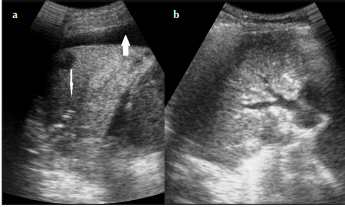Abstract
OBJECTIVES: Computed tomography is considered as the diagnostic gold standard for following up the majority of pediatric chest X-ray (CXR) opacities. However, radiation, cost, and waiting times have led to search for diagnostic alternatives. This study was conducted to determine the diagnostic accuracy of the ultrasound (US) in detecting the causes of pediatric CXR opacities.
MATERIALS AND METHODS: This study was conducted on the pediatric patients with CXR opacity referring to Dr. Sheikh Hospital in Mashhad, Iran during 2016-2017. After undergoing the US exam, the patients were followed to obtain the final diagnosis based on reference standard (RF). The accuracy of the US was calculated in detection of thoracic lesions. P value <0.05 was considered to be significant.
RESULTS: The most common diagnostic cause of CXR opacity based on RF was pneumonia (n=46, 35-38%), thymus (n=37, 28-46%), bone and soft tissue mass (n=12, 9.23%), cystic lesions (n=11, 8.46%), and diaphragmatic lesions (n=10, 7.69%), as well as intrathoracic masses and empyema (n=7, 5.38%). In only four patients (3.07%), the final diagnosis based on RF was inconsistent with the US diagnosis. The diagnostic accuracy of the US was 100% in the diagnosis of bone and soft tissue masses, diaphragmatic lesions, empyema, and normal thymus, and the accuracy was 96.92% for pneumonia, and 99.23% for cystic lesions and intrathoracic masses.
CONCLUSION: Regarding the assessed diagnostic accuracy, the US can be a reliable diagnostic tool to differentiate the main cause of pediatric CXR opacity.
Cite this article as: Lameh A, Seyedi SJ, Farrokh D, et al. Diagnostic value of ultrasound in detecting causes of pediatric chest X-ray opacity. Turk Thorac J 2019; 20(3): 175-81.



.png)

